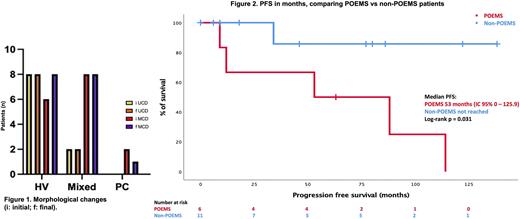Abstract
Introduction
Castleman Disease (CD) depicts a group of heterogeneous hematologic disorders with characteristic histopathological features. Two forms of CD are recognized,unicentric (UCD) or multicentric (MCD). This classification relies on the number of regions of lymph node involvement.
Objetives
To describe the clinicopathological characteristics of a cohort of Hispanic patients with Castleman's Disease.
Material
Patients with CD diagnosis that were followed at the Monoclonal Gammopathies Clinic in INCMNSZ, from January 2006 to July 2022 were included.A team of pathologists that included a trained hematopathologist reviewed the biopsies, extended the immunohistochemical panel and classified the cases according to the International, evidence-based consensus diagnostic criteria for HHV8 negative/idiopathic MCD.
Results
Twenty-seven patients were included. The cases corresponded as follows:16 hyaline vascular/hypervascular variety (HV), 10 mixed variant (MV) and 1 plasma cell variant (PC). Cases were more frequently reclassified in MCD, particularly those with characteristic features of both HV and PC (Fig.1).
Thirty-seven percent (10) were UCD and 63% (17) were MCD; median age at diagnosis was 37 years and 41 years, respectively; a difference in sex predominance was found, with 80 % of women in UCD and 76 % of men in MCD (p=0.018).
In UCD the most frequent nodal areas affected were cervical in 40% (4) and mesenteric in 40% (4). Media nodal size was 7.1 cm (SD 3.5). Eighty percent (8) was HV variety and 20% VM. Successful surgical removal was performed in all cases, therefore none required chemo or radiotherapy.
The group of MCD was distributed as follows: 59% (10) were idiopathic MCD (iMCD), 35% (6) were associated to POEMS syndrome and 6% (1) to HHV8. The 64% had involvement of 3-5 nodal regions. Fifty-nine percent (10) experienced B symptoms, fever was the most frequent; 70% presented fluid retention (5 edema, 3 pleural effusion and 4 ascites); 35% (6) experienced skin involvement. Hepatomegaly was present in 88% (15) and splenomegaly in 53% (9), mean 18.3 cm (SD 19.9% and 14.6 cm (SD 2), respectively.
The treatment received by sixteen patients with MCD was: 63% (10) received rituximab, 19% as monotherapy (3), 19% with corticosteroids (3) and 25% (4) with CHOP-like chemotherapy. Thirty-seven percent (6) received only chemotherapy. Response to treatment was evaluable in 13 patients, 38% (5) achieved a complete response, 38% (5) a partial response, 15% (2) stable disease and one patient progressive disease.
At 66 months follow-up, median overall survival and progression free survival (PFS) have not been reached. Estimated medians are 153.7 months and 107.7 months, respectively.
Patients with MCD associated to POEMS Syndrome relapsed more frequently 83% (5) vs 17% (1) (p=0.005) (Fig. 2), therefore they received more cycles of treatment 7.5 vs 4.4 (p=0.016). None of the patients with UCM have relapsed.
A univariate analysis showed a tendency towards rituximab to reduce relapse risk OR 0.125 (CI 95% 0.013 - 1.245), p=0.076. Uni and multivariate analysis revealed that the association to POEMS Syndrome increased relapse risk OR 50 (IC 95% 2.559 - 976), p=0.010 and OR 31.64 (IC 95% 1.48-676), p=0.027, respectively. Median PFS in this group was 53 months vs non reached in patients with iMCD or associated to HHV8 (p=0.031).
Conclusions
To our knowledge, this is the first series of CD cases in the Latin American population that includes a complete description of the clinical and histopathological characteristics with a reclassification of the same according to current diagnostic criteria.
The revision of the cases, along with the extension of the immunohistochemical panel, and the application of the international evidence-based consensus diagnostic criteria for HHV8 negative/idiopathic multicentric Castleman disease derived in the reclassification of 11% of the cases and opposed to data reported in the literature, the MV corresponded to 20% of UCD and a predominance of cervical nodal involvement.
This study has a longer median follow-up time, 66 months vs 59 months (UC) and 39 months (MCD) in one a series of cases in our country, which allows a better description of the outcomes.
Progression-free survival was inferior in patients with MCD associated to POEMS Syndrome, median 53 months vs non reached (p = 0.031). The poor outcome of this association had not been previously described.
Disclosures
Aguayo:Roche: Speakers Bureau. Martínez-Baños:Janssen: Membership on an entity's Board of Directors or advisory committees, Speakers Bureau; Sanofi: Speakers Bureau; Amgen: Speakers Bureau; BMS: Membership on an entity's Board of Directors or advisory committees, Speakers Bureau.
Author notes
Asterisk with author names denotes non-ASH members.


This feature is available to Subscribers Only
Sign In or Create an Account Close Modal